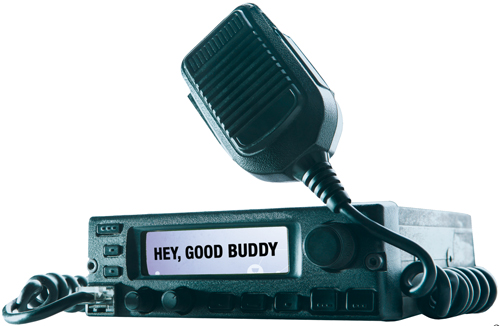Broadband Gets Its Citizenship
By Stewart Schley
New Wireless Frequencies Promise to Transform the Way Cable Companies Connect
Behind the pop-culture embrace of Citizen’s Band Radio during the 1970s was a concept of miniaturization: Enthusiasts were enthralled over the ability to transform radio broadcasting from a medium for the masses to a smaller field of play where individualism was the rule and where relatively few individuals might be listening at any time. The lonely trucker crossing Wyoming late at night could find solace from the voices of a handful of listeners tuned to one of 23 channels designated in the 27 MHz band. Using the Citizen’s Band was a far cry from listening to an AM radio powerhouse like Cincinnati’s WLW, whose 50-kilowatt signal spilled out across much of the eastern U.S., attracting an audience of tens of thousands every night.
Some 40 years later, a similar drive toward the micro over the macro is provoking enthusiasm for a new type of wireless communications service. Citizens Broadband Radio Service (CBRS) is a new entrant on the mobile data scene that permits providers to deploy LTE technologies over a combination of licensed and non-licensed spectrum which is mapped out over tens of thousands of serving areas. Previously, these frequencies belonged exclusively to military radar systems and fixed satellite stations. Now, thanks to a 2015 FCC decision, they’re shared among these incumbents and new, commercial users.
There’s more than raw spectrum at work here. Across the 3.5 GHz band encompassed by CBRS, dedicated databases play the role of frequency wheeler-dealers, parceling out available slots and ensuring there’s no interference between channels. This combination of prized frequencies, managed allocation, uninterrupted use and protection from interference make CBRS an extremely attractive opportunity for mobile communications providers — including cable companies.
Breaker, Breaker
The name “Citizens Broadband” gives CBRS at least some whimsical brand affinity with the CB radio medium popularized in 1970s movies like “Convoy” and “Smokey and the Bandit.” But this new wireless category spawned by an FCC reallocation of spectrum also shares more substantive qualities. Like CB radio, it allows for unlicensed access to its assigned spectrum, meaning users won’t have to invest billions of dollars to buy their way into the market. Also like CB radio, it enables a different set of economics that may invite providers to carve the market into smaller parcels than those of the massive nationwide footprints familiar in today’s consumer wireless industry.

“It’s going to be a great system for innovation,” says Peter Smyth, VP of Core Innovations for CableLabs, who has studied and written about CBRS. “It’s going to give cable companies an opportunity to become micro-mobile operators, and it’s going to provide a great ability to manage quality at economical prices.”
CBRS operates in prime property, spectrum-wise. Employing the capacity- and speed-enhancing techniques of the LTE specification, transmitters push out signals over spectrum that can penetrate walls and ignore physical line-of-sight obstacles. The results include impressive data rates. Tests performed by CableLabs have yielded (indoor) downstream rates of 72 Mbps using two 10 MHz channels with a minimal 2×2 MIMO configuration (two transmit antennas and two receive antennas). As CableLabs points out, that’s 7x faster than today’s average LTE speed. Bonding more channels to aggregate 140 MHz of spectrum tied to a 4×4 MIMO configuration accelerated the downstream rate to greater than 1 Gbps. Proponents say CBRS allows for even faster transmissions outdoors where line-of-sight connections are possible.
These attributes, coupled with an interesting localization element to CBRS, make the opportunity tantalizing for anybody who wants in on the economic growth ride that is wireless data transmission in the U.S. Today the demand for bandwidth seems nearly insatiable, especially as the prominent wireless carriers move to all-you-can-use plans without data caps. These carriers — AT&T, Verizon, T-Mobile and Sprint — need all the bandwidth they can find. All the better if they can obtain it without the complexities of Wi-Fi sharing.
But cable companies also see interesting possibilities in CBRS, for reasons that are both obvious and not-so-obvious.
The easy-to-identify appeal is the same thing that makes Verizon excited about CBRS: raw bandwidth. CBRS opens up a whole new set of highway lanes for feeding bit streams to end users. Granted, iPhones, Samsung Galaxy devices and other mobile handsets sold in the U.S. don’t yet feature built-in antennas that can pluck signals out of the CBRS spectrum. But there’s a broad consensus they’re coming, and soon. Mobile devices that speak CBRS already are available in several international markets, notes CableLabs’ Smyth. So there’s a clear pathway for using CBRS to upgrade the transmission capacity of existing wireless networks.
Wi-Fi Alternative
But CBRS also offers the cable industry a chance to leverage the LTE wireless networking standard without breaking the bank. “In order to use LTE in the past you needed to buy licensed spectrum, which is very expensive,” says Smyth. “That means if you’re a pure cable operator running broadband services, you’re limited to Wi-Fi technology, which itself is great for hotspots and homes, but isn’t mobile. Now, with this shared spectrum, for the first time you can start to exploit it for your customers and tap into the enormous ecosystem for smartphones and devices.”
CBRS also offers interesting possibilities for localized wireless plays. Think about hospitals, for one use case. CBRS offers a sturdy, inexpensive way to sling data around physicians’ offices, patient rooms and bandwidth-gobbling radiology departments with more reliability and greater speed than Wi-Fi networks can muster. A similar appeal holds for sports stadiums or event venues that attract thousands of visitors at the same time. Many sports fans are all too familiar with the experience of having a smartphone time out when trying to emit a text message from Section 307 (or anywhere else) during a live game. CBRS promises a solution in the form of dedicated frequencies over which sessions can be set up and torn down to coincide with the opening kickoff and the final whistle.
The allocation scheme for CBRS invites this sort of highly localized implementation by virtue of geography. It chops up the spectrum across more than 70,000 census tracts determined by population, rather than distance. Each of these serving areas includes no more than 8,000 individuals.
As a result, a densely populated collection of neighborhoods in Brooklyn constitutes its own unique census tract, as does an elongated stretch of Kansas prairie. Being able to aggregate only the spectrum a provider needs to serve small areas or even isolated facilities such as office buildings or schools is a big plus.
And don’t forget the home. Contrary to the early positioning of mobile phone services — remember the iconic movie figure Gordon Gekko strolling the beach with a brick-sized handset affixed to his skull? — most mobile traffic flows to devices like smartphones, laptop and tablets that are used inside homes and buildings. That means in most cases it’s unnecessary to keep handing off calls from cell tower to cell tower as chatty users drive down the highway. (If you’re skeptical here, ask any teenager to pinpoint the last time they used a mobile “phone” to actually make a voice call.) Cable companies can take advantage by connecting CBRS users directly to their fiber/coax networks, bypassing the cellular firmament partly or entirely.
Of course, cable companies aren’t the only players to recognize the allure of CBRS. But they may be in a better position than others to exploit the opportunity for a couple of reasons. One is localism: Cable companies have a physical presence in lots of places. Another is electrical power. Getting electricity to the constellations of small microcells needed to emit signals using CBRS can be expensive. Cable companies have a built-in head start by virtue of on-network powering systems used to enable DOCSIS data networks. “People forget that one of the most difficult and expensive propositions here is getting power to these small cells,” Smyth says.
Smyth, who worked previously for British Telecom, isn’t all-in on CBRS just yet. He advises cable companies to be “a bit skeptical” early on about the consumer/ mass-market opportunity, which depends mightily on the willingness of Apple, Samsung and other manufacturers to embed CBRS antennas into their devices. He thinks the earlier promise will come from site-by-site connectivity, likely tied to add-on dongles that are used to connect laptops and other devices. But he’s an unabashed enthusiast about the broader cable-wireless romance. Smyth points out CableLabs now has more staff members devoted to studying wireless technologies than DOCSIS implementations. If you don’t believe that’s a sign of the times, you’re probably tuned to the wrong frequency, good buddy.
 Stewart Schley,
Stewart Schley,
Media/Telecom Industry Analyst
stewart@stewartschley.com
Stewart has been writing about business subjects for more than 20 years for publications including Multichannel News, CED Magazine and Kagan World Media. He was the founding editor of Cable World magazine; the author of Fast Forward: Video on Demand and the Future of Television; and the co-author of Planet Broadband with Dr. Rouzbeh Yassini. Stewart is a contributing analyst for One Touch Intelligence.
Shutterstock.com




